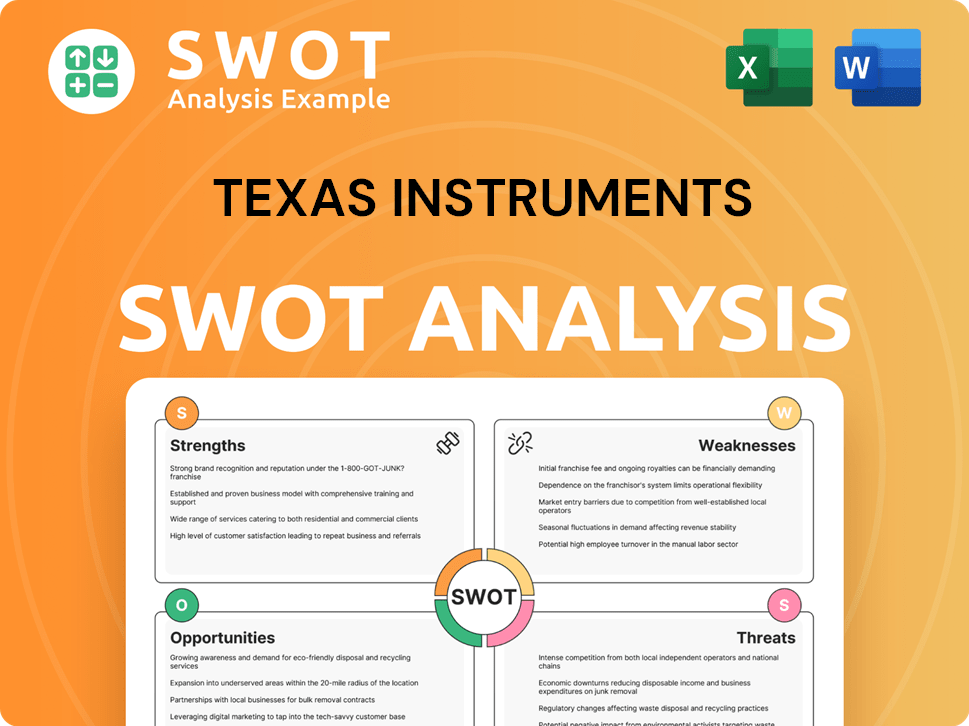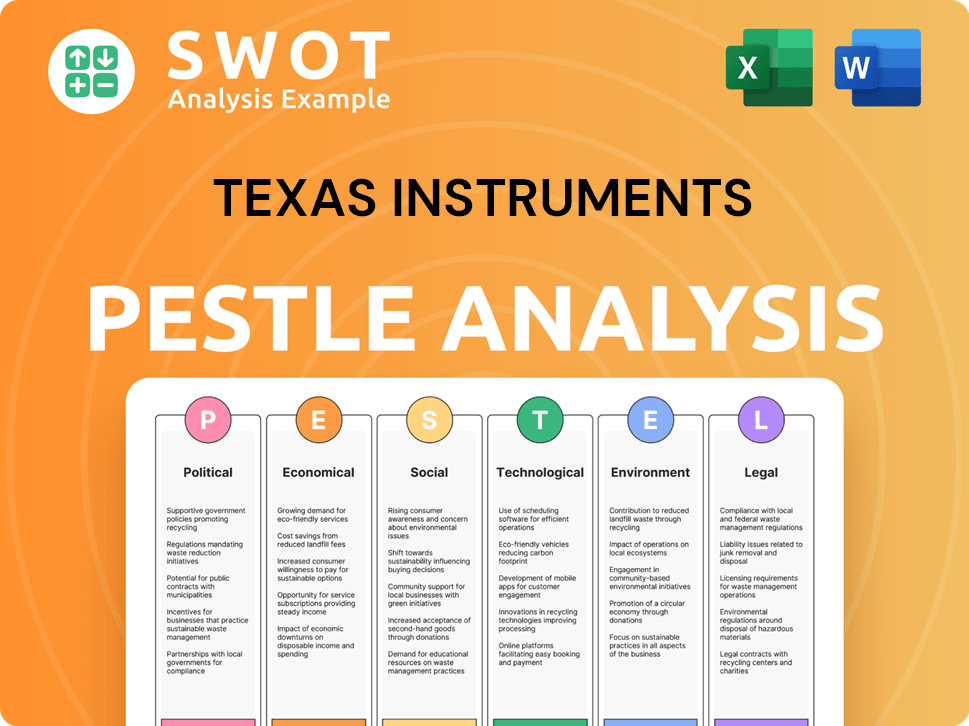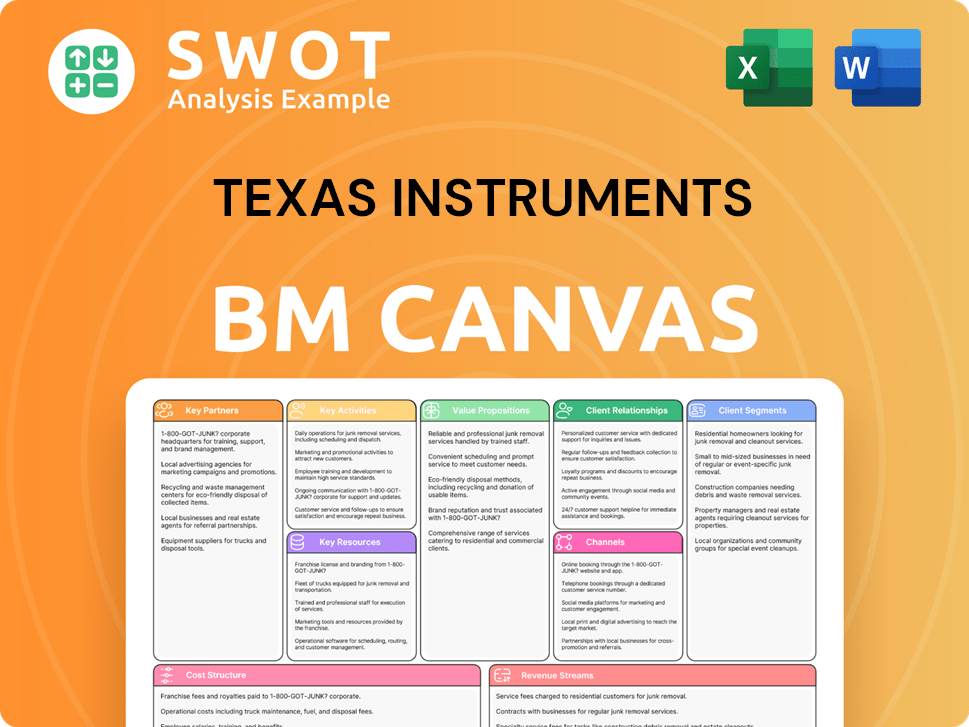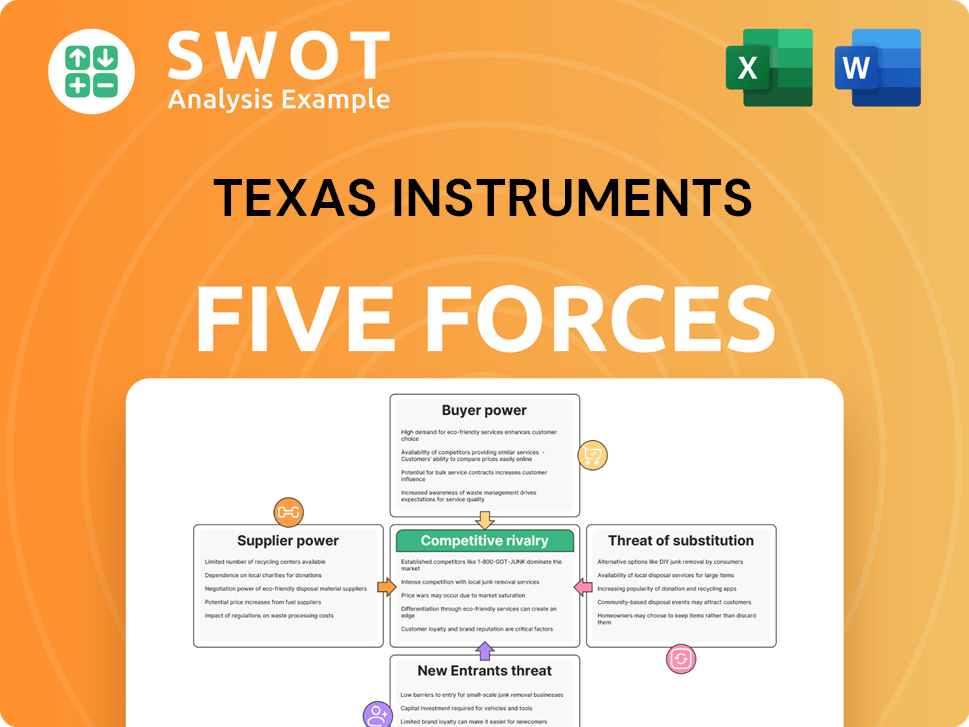Texas Instruments Bundle
Can Texas Instruments Maintain Its Semiconductor Dominance?
In the cutthroat world of semiconductors, where innovation is constant and competition is fierce, Texas Instruments (TI) has long been a major player. From its origins in seismic exploration to its current status as a global leader, TI's journey is a fascinating study in strategic evolution. But how does this industry giant fare against its rivals in the dynamic Texas Instruments SWOT Analysis?

Understanding the Texas Instruments competitive landscape is crucial for any investor or industry observer. This analysis will dissect TI competitors, explore its Texas Instruments market analysis, and evaluate its strategic positioning in the semiconductor industry. We'll examine its strengths in analog and embedded processors, its TI market share, and how it navigates the challenges of a rapidly changing technological environment. This deep dive will provide actionable insights into TI's future prospects.
Where Does Texas Instruments’ Stand in the Current Market?
Texas Instruments (TI) holds a significant position in the semiconductor industry, particularly in analog and embedded processing. The company's focus on these core segments has allowed it to maintain a strong competitive edge. This strategic focus has resulted in a robust market presence and financial performance.
TI's competitive landscape is defined by its strong market share and diverse product offerings. The company's ability to cater to various sectors, including industrial, automotive, and personal electronics, has contributed to its sustained success. This diversification is a key factor in its resilience.
In 2023, TI maintained its position as the leading analog chip supplier globally. This leadership is a testament to its strong market position and strategic focus. For a detailed look at their growth strategy, you can read this article: Growth Strategy of Texas Instruments.
TI is the largest analog chip supplier worldwide. In 2023, TI held a substantial 19% market share in the analog semiconductor market, which was valued at $83.6 billion. This dominance is a key indicator of its competitive strength and market position.
TI reported revenues of $17.5 billion in 2023. The company's net income for the same year was $6.5 billion. These figures underscore TI's robust financial health and its ability to generate consistent profitability.
TI strategically targets high-volume, long-life products, particularly in the industrial and automotive markets. Approximately 76% of TI's revenue in 2023 came from these sectors. This focus has allowed TI to capitalize on the increasing demand for semiconductors in these resilient sectors.
TI's extensive product portfolio includes power management, signal chain, and high-volume analog products. These products cater to a broad range of applications, including industrial automation, automotive systems (such as ADAS), and personal electronics. The diverse applications contribute to TI's market reach.
TI's competitive advantages stem from its strong market share in analog, diversified customer base, and strategic focus on industrial and automotive markets. These factors contribute to its sustained revenue streams and profitability.
- Leading market share in the analog semiconductor market.
- Strong presence in the industrial and automotive sectors.
- Diverse product portfolio catering to various applications.
- Consistent financial performance and profitability.
Texas Instruments SWOT Analysis
- Complete SWOT Breakdown
- Fully Customizable
- Editable in Excel & Word
- Professional Formatting
- Investor-Ready Format

Who Are the Main Competitors Challenging Texas Instruments?
The competitive landscape for Texas Instruments (TI) is complex, spanning both analog and embedded processing segments. The company faces a diverse set of rivals, from large, diversified semiconductor firms to specialized niche players. Understanding the competitive dynamics is crucial for assessing TI's market position and future prospects. A comprehensive Brief History of Texas Instruments can provide further background on the company's evolution and strategic focus.
TI's market analysis reveals a highly competitive environment where innovation and strategic positioning are key. The semiconductor industry, particularly the analog and embedded processors sectors, is characterized by rapid technological advancements, shifting market demands, and intense competition for market share. TI's ability to maintain its competitive edge depends on its product portfolio, pricing strategy, and global presence.
In 2024, the semiconductor market continues to be dynamic, with fluctuations in demand and supply affecting all players. The competitive landscape is constantly evolving due to mergers, acquisitions, and technological advancements.
In the analog market, TI's main rivals include Analog Devices (ADI), STMicroelectronics, Infineon Technologies, and NXP Semiconductors. These companies offer a wide range of analog and mixed-signal integrated circuits. They often compete directly with TI in various sectors.
The embedded processing segment sees competition from NXP Semiconductors, Renesas Electronics, Microchip Technology, and Qualcomm. These companies focus on microcontrollers and secure connectivity solutions, particularly in the automotive and industrial sectors.
TI's market share is constantly challenged by its competitors. The semiconductor industry is highly competitive, with companies vying for market share through innovation, pricing, and strategic partnerships. Understanding TI's market position in 2024 requires analyzing its financial performance compared to its competitors.
The automotive sector is a significant battleground for TI and its competitors. Companies like NXP, Infineon, and Renesas have a strong presence in this market. TI's market share in automotive is crucial for its overall revenue and growth.
Mergers and acquisitions reshape the competitive landscape. The acquisition of Cypress Semiconductor by Infineon is an example of how the industry evolves. These deals create larger, more integrated rivals.
Emerging players continually disrupt the market with innovative solutions for specific applications. These smaller firms can pose a challenge to established companies by offering specialized products and services.
A competitive analysis of Texas Instruments involves evaluating its strengths and weaknesses against its main rivals. This includes assessing their product portfolios, pricing strategies, and market reach. The following are key aspects to consider:
- Analog Devices (ADI): A direct competitor with a broad portfolio of high-performance analog and mixed-signal integrated circuits.
- STMicroelectronics: Strong presence in the automotive and industrial sectors, particularly in power management and microcontrollers.
- Infineon Technologies: Competes in automotive and industrial sectors, especially in power management and microcontrollers.
- NXP Semiconductors: Competes in automotive and industrial embedded processing, particularly in microcontrollers and secure connectivity solutions.
- Renesas Electronics: Focuses on automotive and industrial microcontrollers and analog products.
- Qualcomm: Increasingly competes in automotive infotainment and ADAS.
Texas Instruments PESTLE Analysis
- Covers All 6 PESTLE Categories
- No Research Needed – Save Hours of Work
- Built by Experts, Trusted by Consultants
- Instant Download, Ready to Use
- 100% Editable, Fully Customizable

What Gives Texas Instruments a Competitive Edge Over Its Rivals?
Understanding the competitive landscape of Texas Instruments (TI) involves recognizing its key strengths and how it differentiates itself in the semiconductor industry. The company's strategic moves, particularly in analog and embedded processing, have solidified its market position. A deep dive into TI's competitive advantages reveals the factors that contribute to its sustained success and resilience against its rivals.
Key to TI's dominance is its extensive product portfolio and operational efficiency. These elements, combined with a focus on long-term value creation, allow TI to maintain a strong competitive edge. The company's ability to navigate the dynamic semiconductor market is a testament to its strategic foresight and commitment to innovation.
TI's competitive advantages are multifaceted, contributing to its strong market position. These advantages include a vast product portfolio, operational efficiency, and a focus on long-term value creation. The company's strategies have allowed it to maintain a strong competitive edge in the dynamic semiconductor market. For a deeper understanding of their marketing approach, consider exploring the Marketing Strategy of Texas Instruments.
TI boasts an extensive product catalog, with over 80,000 products, primarily in analog semiconductors. This broad range allows TI to serve diverse customer needs across various applications. The focus on high-volume, general-purpose parts provides significant economies of scale and broad market penetration.
TI's operational efficiency is a key advantage. The company's investment in 300-millimeter wafer fabrication capabilities allows for lower production costs. Its direct sales model and customer support network foster strong client relationships. Long product lifecycles, especially in industrial and automotive applications, ensure stable revenue streams.
TI's manufacturing capabilities are a significant advantage. The company's investment in its internal 300-millimeter wafer fabrication facilities allows for lower costs per die. This enhances profitability and enables competitive pricing. This strategic investment underscores TI's commitment to cost-effective production.
TI's direct sales model and extensive customer support network foster strong relationships with clients, leading to high customer loyalty and recurring revenue. These relationships are crucial for understanding and meeting customer needs. This approach helps maintain a competitive edge in the market.
TI's competitive advantages include a vast product portfolio, operational efficiency, and strong customer relationships. These factors contribute to its resilience and market leadership. The company's focus on long-term value creation and strategic investments further solidify its position.
- Extensive product range, with over 80,000 products.
- Efficient manufacturing through 300-millimeter wafer fabrication.
- Strong customer relationships and high customer loyalty.
- Long product lifecycles, particularly in industrial and automotive sectors.
Texas Instruments Business Model Canvas
- Complete 9-Block Business Model Canvas
- Effortlessly Communicate Your Business Strategy
- Investor-Ready BMC Format
- 100% Editable and Customizable
- Clear and Structured Layout

What Industry Trends Are Reshaping Texas Instruments’s Competitive Landscape?
The semiconductor industry is experiencing significant shifts, creating both opportunities and challenges for companies like Texas Instruments. Factors such as the increasing demand for semiconductors in the automotive sector, industrial automation, and the Internet of Things (IoT) are driving growth. However, geopolitical tensions, supply chain issues, and intense competition pose risks to TI's market position. A detailed Texas Instruments market analysis reveals the complexities of its competitive landscape.
Understanding these trends is crucial for evaluating TI's future prospects. TI's ability to adapt to technological advancements, manage geopolitical risks, and maintain its competitive edge will determine its success in the coming years. Strategic decisions regarding product development, market expansion, and operational efficiency will be critical for sustaining growth and profitability.
The semiconductor industry is growing, particularly in the automotive and industrial sectors. Electric vehicles (EVs), autonomous driving, and advanced driver-assistance systems (ADAS) are boosting demand. Industrial automation and IoT also drive demand for analog and embedded processing solutions. This expansion provides opportunities for companies like TI that focus on these areas.
Geopolitical tensions and supply chain disruptions can impact manufacturing and delivery. Trade disputes and regional self-sufficiency efforts may increase costs. Intense competition from Chinese semiconductor companies and well-funded startups also poses a threat. Continuous investment in research and development is crucial for innovation.
TI can expand its market share in high-growth areas such as power management for renewable energy, battery management for EVs, and edge AI processing. Leveraging manufacturing efficiency, a broad product portfolio, and strong customer relationships are key. Strategic moves can help navigate challenges and capitalize on emerging opportunities.
The competitive landscape includes companies like Analog Devices, with ongoing innovation and market share battles. TI's ability to innovate and adapt is crucial. The company's financial performance, including revenue breakdown and pricing strategies, will be key to maintaining its competitive advantage.
TI's focus on long-lifecycle markets like automotive and industrial positions it well for sustained growth. However, the company must navigate geopolitical risks and supply chain issues. Strengthening its presence in high-growth areas, like EV battery management, is essential.
- Market Position: TI holds a significant market share in analog and embedded processors, particularly in the automotive sector.
- Technological Advancements: Continuous investment in R&D is crucial to stay ahead of competitors and maintain innovation in the semiconductor industry.
- Financial Performance: TI's financial health is critical. The company's revenue and profit margins must be closely monitored.
- Competitive Strategy: TI must effectively compete with rivals, such as Analog Devices, and manage its pricing strategy to maintain profitability.
Texas Instruments Porter's Five Forces Analysis
- Covers All 5 Competitive Forces in Detail
- Structured for Consultants, Students, and Founders
- 100% Editable in Microsoft Word & Excel
- Instant Digital Download – Use Immediately
- Compatible with Mac & PC – Fully Unlocked

Related Blogs
- What are Mission Vision & Core Values of Texas Instruments Company?
- What is Growth Strategy and Future Prospects of Texas Instruments Company?
- How Does Texas Instruments Company Work?
- What is Sales and Marketing Strategy of Texas Instruments Company?
- What is Brief History of Texas Instruments Company?
- Who Owns Texas Instruments Company?
- What is Customer Demographics and Target Market of Texas Instruments Company?
Disclaimer
All information, articles, and product details provided on this website are for general informational and educational purposes only. We do not claim any ownership over, nor do we intend to infringe upon, any trademarks, copyrights, logos, brand names, or other intellectual property mentioned or depicted on this site. Such intellectual property remains the property of its respective owners, and any references here are made solely for identification or informational purposes, without implying any affiliation, endorsement, or partnership.
We make no representations or warranties, express or implied, regarding the accuracy, completeness, or suitability of any content or products presented. Nothing on this website should be construed as legal, tax, investment, financial, medical, or other professional advice. In addition, no part of this site—including articles or product references—constitutes a solicitation, recommendation, endorsement, advertisement, or offer to buy or sell any securities, franchises, or other financial instruments, particularly in jurisdictions where such activity would be unlawful.
All content is of a general nature and may not address the specific circumstances of any individual or entity. It is not a substitute for professional advice or services. Any actions you take based on the information provided here are strictly at your own risk. You accept full responsibility for any decisions or outcomes arising from your use of this website and agree to release us from any liability in connection with your use of, or reliance upon, the content or products found herein.